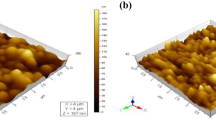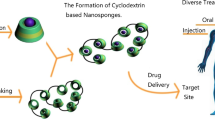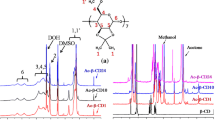Abstract
Cyclodextrin based carbonate nanosponges were synthetized starting from native β-cylodextrin and active carbonyl compounds i.e. carbonildiimidazole. In this work they were used to form inclusion complexes with three different gases i.e. 1-methylcyclopropene, oxygen and carbon dioxide. The encapsulation of gases were proved by direct reaction to known adduct (1-methylcyclopropene), by gravimetric analysis (CO2) and by oxymeter (Oxygen). The complexetion of oxygen or carbon dioxide could be useful for many biomedical applications. In particular the oxygen-filled nanosponges could supply oxygen to the hypoxic tissues which are present in various deseases. 1-methylcyclopropene included in β-cyclodextrin nanosponges showed superior antiethylenic performances in long lasting cut flowers in comparison with marketed products.







Similar content being viewed by others
References
Rudkevich, D.M., Leontiev, A.Y.: Molecular incapsulation of gases. Aust. J. Chem. 37, 713–722 (2004)
Ridha, F.N., Webley, P.A.: Investigation of the possibility of low pressure encapsulation of carbon dioxide in potassium chabazite (KCHA) and sodium chabazite (NaCHA) zeolites. J Colloid Interface Sci 337, 332–337 (2009)
Kostansek, E.C.: Delivery system for cyclopropene requiring less water EPA 1 192 858 A1 (2002)
Yoon, J.H., Huh, M.W.: Encapsulation of simple gases in zeolites. J. Phys. Chem. 98, 3202 (1994)
Al-Otaibi, F., Clarke, M., Maini, B., Bishnoi, P.R.: Formation kinetics of structure I clathrates of methane and ethane using an in situ particle size analyzer. Energy Fuels 24(9), 5012–5022 (2010)
Rudkevich, D.M., Kang, Y., Leontiev, A.V., Organo, V.G., Zyryanov, G.V.: Molecular container for NOx gases. Supramol. Chem. 17, 93 (2005)
Kellersberger, K.A., Anderson, J.D., Ward, S.M., Krakowiak, K.E., Dearden, D.V.: Encapsulation of N2, O2, Methanol or Acetonitrile by Decamethylcurcubit-5-uril complexes in the gas phase. J. Am. Chem. Soc. 123, 11316 (2001)
Terrones, M., Kamalakaran, R., Seeger, T., Ruhle, M.: Novel nanoscale gas containers: encapsulation of N2 and CNx nanotubes. Chem. Commun. 2335 (2000)
Cramer, F., Henglein, M.: Einschlussverbindungen der cyclodextrine mit gasen. Angew. Chem. 68, 649 (1956)
Szejtli, J.: Cyclodextrin Technology, pp. 165–166. Kluwer Academic Publishers, Dordrecht (1998)
Trotta, F., Tumiatti, V.: Cross-linked polymers based on cyclodextrins for removing polluting agents. WO 03/085002 A1
Trotta, F., Cavalli, R.: Characterization and applications of new hyper-cross-linked cyclodextrins. Compos. Interface 16, 39–48 (2009)
Cavalli, R., Trotta, F., Tumiatti, W.: Cyclodextrin-based nanosponges for drug delivery. J. Inclusion Phenom. 56, 209–213 (2006)
Magid, R.M., Clarke, T.C., Ducan, C.D.: J. Org. Chem. 36, 1320 (1971)
Hof, F., Craig, S.L., Nuckolls, C., Rebek, J.J.: Molecular encapsulation. Angew. Chem. Int. Ed. 41, 1488–1508 (2002)
Blankenship, S.M., Dole, J.M.: 1-Methylcyclopropene: a review. Postharvest Biol. Technol. 28, 1–25 (2003)
Ledon, H., Larnicol, P., Desmurs M.J., Dupont, P.: Process for the preparation of cyclodextrins or other compounds capable of producing clathrates with a gas. US Patent 5589590 (1994)
Neoh, T.L., Yoshii, H., Furuta, T.: Encapsulation and release characteristics of carbon dioxide in α-cyclodextrin J. Inclus. Phenon. 56, 125–133 (2006)
Cavalli, R., Ansari, K., Biscazza, A., Giustetto, P., Trotta, F., Vavia, P.: Nanosponge formulations as long-term oxygen delivery systems. Int. J. Pharm. 402, 254–257 (2010)
Van Liew, H.D., Burkard, M.E.: Relationship of oxygen content to PO2 for stabilized bubbles in the circulation: theory. J. Appl. Physiol. 81, 500–508 (1996)
Author information
Authors and Affiliations
Corresponding author
Rights and permissions
About this article
Cite this article
Trotta, F., Cavalli, R., Martina, K. et al. Cyclodextrin nanosponges as effective gas carriers. J Incl Phenom Macrocycl Chem 71, 189–194 (2011). https://doi.org/10.1007/s10847-011-9926-5
Received:
Accepted:
Published:
Issue Date:
DOI: https://doi.org/10.1007/s10847-011-9926-5




